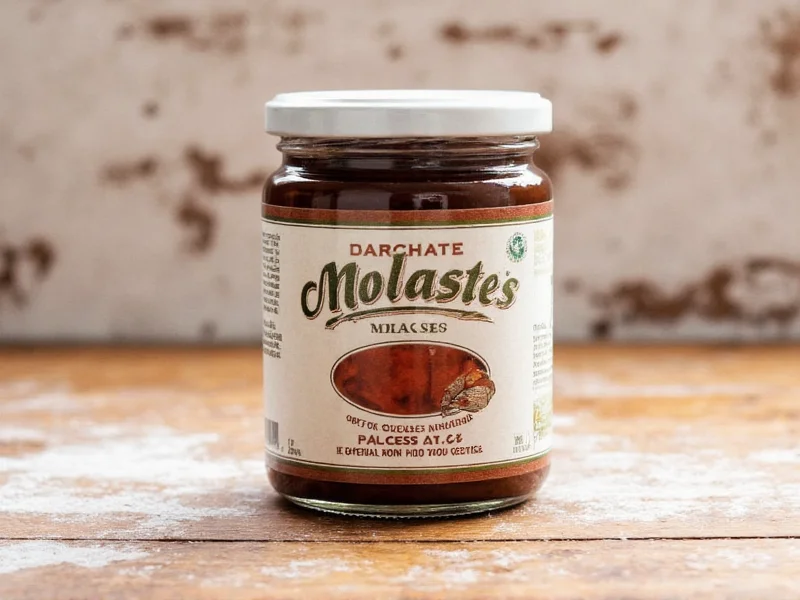Understanding proper molasses storage prevents unnecessary kitchen clutter while ensuring you always have this versatile sweetener ready for baking, glazes, and marinades. This comprehensive guide explains exactly how to store molasses for maximum freshness and shelf life without wasting refrigerator space.
The Science Behind Molasses Storage
Molasses' exceptional shelf stability comes from its chemical composition. With sugar concentrations typically between 75-85%, molasses creates an environment where bacteria and mold cannot thrive. The low water activity (aw) level of approximately 0.6-0.7 makes it inhospitable for microbial growth that causes spoilage in most foods.
Unlike dairy products or fresh juices that require refrigeration for safety, molasses belongs to the category of naturally preserved pantry staples alongside honey, maple syrup, and corn syrup. The high osmotic pressure from concentrated sugars essentially preserves itself.
Storage Recommendations by Molasses Type
Different varieties of molasses have slightly different storage considerations. The table below outlines optimal storage methods for each type:
| Molasses Type | Unopened Storage | Opened Storage | Expected Shelf Life |
|---|---|---|---|
| Light Molasses | Pantry, cool dark place | Pantry or refrigerator | 2-3 years |
| Dark Molasses | Pantry, cool dark place | Pantry or refrigerator | 2-3 years |
| Blackstrap Molasses | Pantry, cool dark place | Pantry or refrigerator | 2-3 years |
| Sulfured Molasses | Pantry, cool dark place | Pantry (refrigeration not recommended) | 1-2 years |
Practical Storage Guidelines
For optimal molasses storage, follow these evidence-based recommendations:
Pantry Storage (Recommended Method)
Store opened molasses in its original container with the lid tightly sealed in a cool, dark pantry location away from heat sources. The ideal temperature range is 50-70°F (10-21°C). Avoid storing near your stove, oven, or dishwasher where temperature fluctuations occur.
Properly stored molasses may thicken slightly over time but remains perfectly safe and usable. If your molasses becomes too thick for your needs, gently warm the closed container in a bowl of warm water for 10-15 minutes before use.
Refrigeration Considerations
While refrigeration isn't necessary for safety, some home bakers choose to refrigerate molasses if they:
- Live in extremely hot climates (consistently above 85°F/29°C)
- Want to maximize shelf life beyond 2 years
- Prefer a thicker consistency for certain recipes
If you refrigerate molasses, always return it to room temperature before use for easier pouring and mixing. Cold molasses becomes significantly more viscous and difficult to measure accurately.
Recognizing Spoilage in Molasses
Though rare, molasses can eventually degrade. Watch for these clear signs that your molasses has spoiled and should be discarded:
- Mold growth - Any visible mold, even in small amounts
- Unusual odor - Sour, alcoholic, or fermented smells
- Texture changes - Separation that doesn't remix with stirring
- Off flavors - Sour or unpleasant taste (test after heating)
Properly stored molasses typically remains safe well beyond printed expiration dates. The "best by" date indicates peak quality rather than safety cutoff. Many users successfully use molasses 3-5 years past this date with no issues when stored correctly.
Maximizing Molasses Freshness
Follow these professional tips to keep your molasses in optimal condition:
- Always use clean, dry utensils when handling molasses to prevent introducing moisture
- Tighten lids immediately after use to minimize air exposure
- Consider transferring to a smaller container as levels decrease to reduce air space
- Store in glass containers if possible, as they provide better protection against flavor transfer
- Keep away from strong-smelling foods that might affect flavor through container permeation
Special Considerations for Baking and Cooking
Temperature affects molasses' performance in recipes. Room temperature molasses blends more easily into batters and doughs. If you've refrigerated your molasses, allow it to return to room temperature (about 2 hours) before baking for best results.
Chefs note that refrigerated molasses may temporarily separate when brought to room temperature. Simply stir gently to recombine before using. This separation is normal and doesn't indicate spoilage.











 浙公网安备
33010002000092号
浙公网安备
33010002000092号 浙B2-20120091-4
浙B2-20120091-4